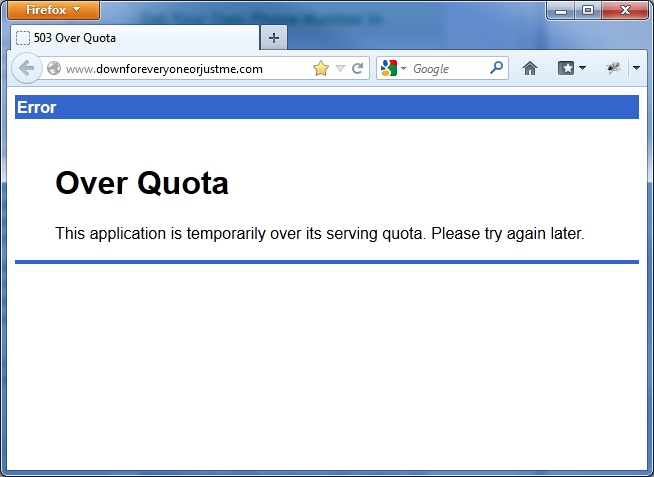
Wow. The GoDaddy outage took down downforeveryoneorjustme.com.
Indirectly, of course, but still…
There’s nothing like finding an edge case for a program you’ve written, thinking “Oh no, I didn’t take that into account!”…then checking the code and realizing that you already did.
 So, I’ve joined the tablet generation. I recently bought a Nexus 7, Google’s latest 7″ tablet. Here are some first impressions.
So, I’ve joined the tablet generation. I recently bought a Nexus 7, Google’s latest 7″ tablet. Here are some first impressions.
Performance is very nice. The games I’d played on my (almost two-year-old) phone are much snappier, plus of course the bigger screen helps a lot.
Within minutes I was typing a lot faster than on my phone, at least when holding it horizontally. Downsides: It’s easy to hit the menu buttons while trying to hit the space bar. Editing is a pain. I miss having arrow keys or a trackball.
The screen size and resolution are just inside the edge of being able to read a full page of a comic book without resorting to guided view. This will change as I get older, but tech will no doubt improve, and I may end up using a larger tablet in the future. I just wish comiXology’s app made it easier to locate comics I’ve already purchased and want to download.
Backup/restore pulled in all my WiFi settings from my phone, which was convenient.
A tablet is much nicer for catching up on news/email/Facebook at breakfast than a phone. Or a desktop or laptop, for that matter. It’s also nice if you drop in at Coffee Bean to relax for a half hour.
My toddler loves the tablet. A few days ago while I set up his breakfast, he grabbed it off the table, set it on the floor, opened the cover, and tried tapping on the screen to wake it up. So far I’ve let him play Fruit Ninja and a couple of interactive kids’ books. He doesn’t quite have the coordination to avoid the edge of the screen, though, so he keeps bringing up a search or dropping back to the home screen while he’s trying to play. I need to find an app to temporarily lock in the running app, so that (a) he won’t get too frustrated and (b) I can look away for 30 seconds and not worry that he’ll end up clicking on an ad for something.
Reading a novel in ordinary indoor light was just fine, and comparable to reading on a Kindle 2. It’s not that great in bright sunlight, though.
Book Navigation on the Google Play Reader takes some getting used to. I’m reading Year Zero, which has a lot of footnotes. You can tap the number to jump to the note, but I kept missing it, or missing the link back to the source. And then trying to return, I’d accidentally tap the slider, jumping forward 1/3 of the way through the book, and reflexively hit the Back button, which doesn’t go back to where you left off, but goes back to the home screen. By the second chapter, I’d stopped reading the footnotes as I got to them and figured I’d just read them when I got to the end of the chapter, which of course removes them entirely from context.
I don’t really mind not having a camera (except the front-facing one for conferencing), because it’s a bit bulky for a camera if I’m not going to get the benefit of actual optics out of it, and I usually have a phone or actual camera anyway.
I am sort of regretting that it’s Wi-Fi only, though, because intermittent access does limit things a bit. Anything you’ve already downloaded is fine, of course, but Google Docs Drive is virtually useless without a connection. I definitely need to look for some sort of local word processing app for writing offline notes. On the plus side, it reconnects automatically to remembered networks, and Gmail at least seems to sync immediately — both with incoming and outgoing mail, so you can read, compose and “send” offline, and new messages will go out as soon as you’re back in WiFi range. (Also, I don’t have to add another $25/30 monthly data plan on top of both our phones.)
Overall, I’m liking it a lot. It’s great for casual reading, communication, and games, and it looks like it’ll work well for writing. I need to look for a decent image editor and offline word processor, and fix a few issues with my WordPress install (I’m using a CDN tool on this site that doesn’t play nicely with image uploads from the mobile app), and I think it’ll be great for travel as well.
Update: Nothing to do with the tablet itself, but I can’t believe WordPress’ Android app still has the bug where if you upload a draft, it pre-fills the publication date so that the post ends up being back-dated when you finally finish it.
A lot of articles on SEO make me cringe, because they tend to have the attitude that Google (and it’s always Google) owes them traffic because they jumped through all the right hoops, and how dare they ever change what those hoops are!
It’s refreshing to see an article by someone who recognizes that Google’s job is not to give websites high rankings, but to show readers what they’re searching for. Their algorithm is a way of measuring how closely you match that goal, not the goal itself.
Doing your SEO solely by targeting today’s algorithms is like only studying what you know is going to be on a test: it might work for this test, but it won’t help as much on the next one…or when you get out into the real world.
People aren’t looking for backlinks and keyword density. People are looking for content. In the end, no matter how tricked out your SEO is, it’s compelling content that keeps people coming back.
We attended Planetfest in Pasadena yesterday. It’s still going on now, a two-day event by the Planetary Society timed to match tonight’s landing of NASA’s Curiosity space probe on Mars.
I wasn’t really sure what to expect, but it was basically a bunch of space enthusiasts and people in the industry. SpaceX has a mock-up of their crew capsule, and other sponsors had exhibits with things like space plane mock-ups or geological drills. There was a life-size inflatable model of the Curiosity rover. There was a single track of programming with speakers on topics from the actual science of Martian exploration to the question of just why we explore space in the first place. Katie caught the Sally Ride tribute while I walked J around the exhibits, and we both watched Bill Nye’s talk about “Our Place in Space,” which he finished up with a fun science demonstration featuring liquid nitrogen marshmallows, gas toruses, a candle, and Robert Picardo.
The exhibits for “kids of all ages” turned out to be for kids from 4 on up. J wasn’t really interested in the Martian soil uplift demo, or the dirty snowball CO2 comet demo, but he liked watching the Xbox Mars Lander game, and he was fascinated by the robot that picked up and tossed basketballs. He had fun hanging out with grandma and grandpa, at least, and playing with a magnetic meteorite. (The tiny fragment of verified Martian meteorite was carefully mounted on a slab with plastic wrap to protect it from skin oils, but they had a couple of non-valuable rocks that you could pick up and hold.)
A family friend invited us to the after party at the mall across the street. It was divided into two main areas: the sci-fi-themed dance floor out on the plaza, and a set of tables on the terrace above for the sit-and-talk crowd, where the main event was a participatory art project: A group had set up one blank postcard for each day of Curiosity’s journey from Earth to Mars, and was asking attendees to draw what they imagined the probe would write home about.

ShareThis is rolling out a tool for “frictionless sharing.” That’s the term for those apps or widgets that “let” you broadcast everything you do on a site to your social network. I suppose it sounds great for publishers, because your content gets shared more, but…
As someone who reads stuff online, “Frictionless sharing” is a privacy disaster waiting to happen. Undo is nice, but in a world where updates are pushed instantly, you can’t count on it.
As someone who follows social networks, it’s just more noise. I don’t want to know every article you read in your latest wiki walk. I’ll tune it out, or I’ll tune you out. What I want to know is which articles, photos and videos you think are worth sharing.
Fury after Facebook messes up smartphone users’ address books:
Remember how Facebook sneakily changed your default email address to @facebook.com? … Some smartphone users…are reporting that their on-phone address books have been silently updated to make @facebook.com email addresses the default way to send a message to their contacts.Graham Cluley at Sophos
The lesson: Whenever you change something, always consider the impact on things that depend on it.
This reminds me of the ill-fated Network Solutions attempt to replace failed DNS lookups with responses directing web browsers to search pages, not considering that web browsers aren’t the only software that uses DNS, or that some of that software might depend on accurate “this domain does not exist” info.
Originally posted on Google+